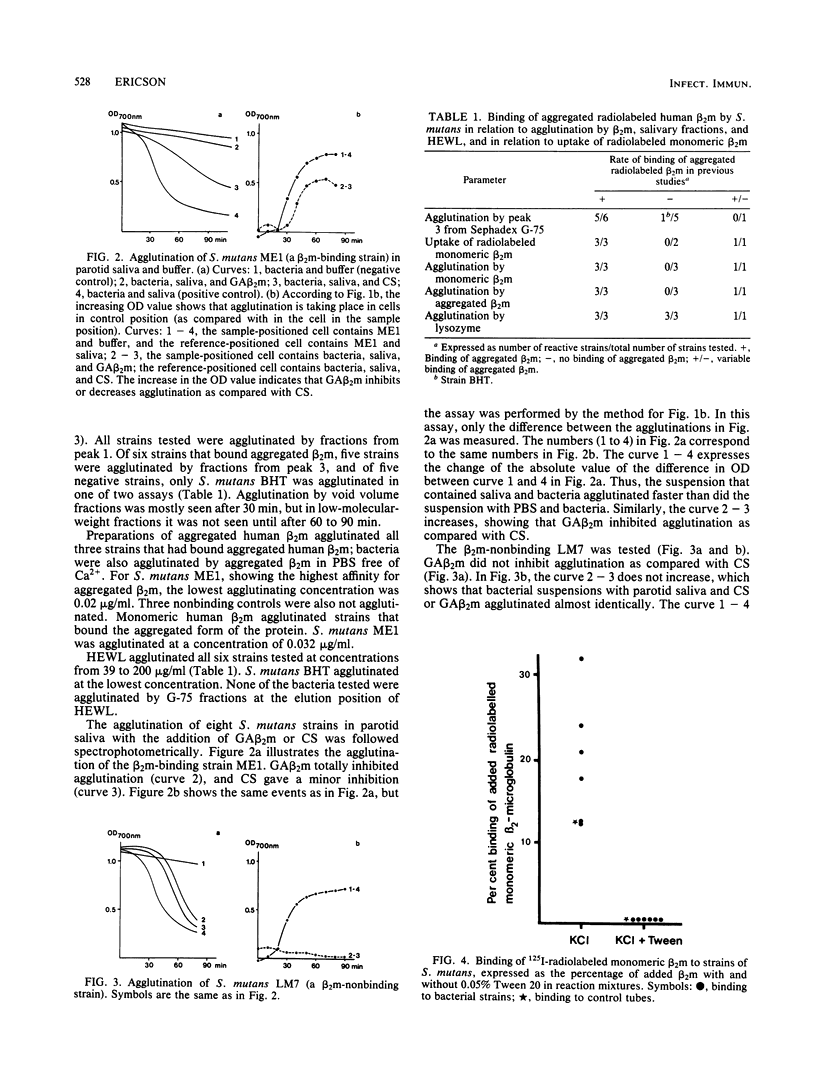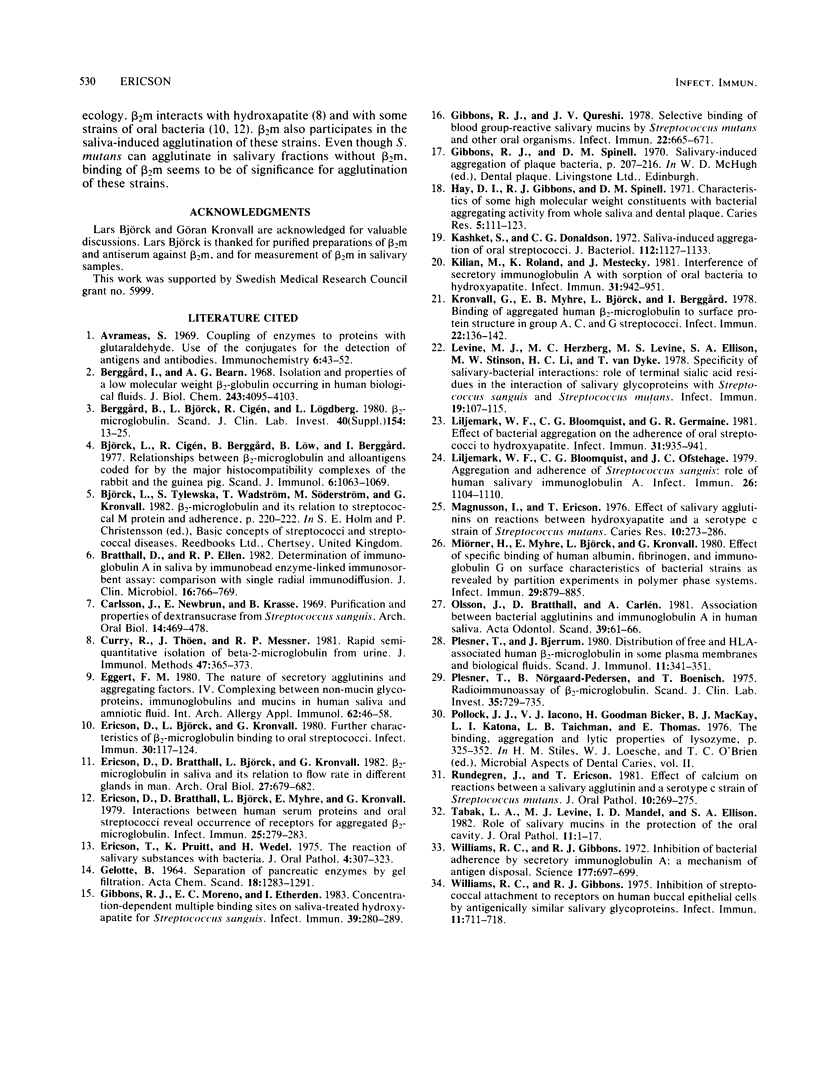Abstract
Radiolabeled monomeric human beta 2-microglobulin (beta 2m) was tested for binding to Streptococcus mutans strains in buffers containing 1 mM calcium (Ca2+). Binding was seen to strains with a previously established binding capacity of aggregated beta 2m. Monomeric beta 2m agglutinated beta 2m-binding strains when Ca2+ was present. At Ca2+ concentrations of 1.4 mM, 0.032 micrograms of monomeric beta 2m per ml caused bacterial agglutination. Parotid saliva was gel filtered on a Sephadex G-75 column, and low-molecular-weight fractions containing beta 2m could agglutinate S. mutans cells. Five of six strains that could bind beta 2m were agglutinated by these fractions, but only one of five nonbinding strains was. All strains tested were agglutinated by void volume fractions. A new method for the measurement of turbidity in bacterial agglutination inhibition experiments with parotid saliva was used. Suspensions containing parotid saliva, bacteria, and control serum were directly compared in a spectrophotometer with test suspensions containing goat anti-human beta 2m, bacteria, and saliva. Thus, the spectrophotometer directly read the difference in agglutination of the two suspensions, and the result was presented as one curve by the recorder. Agglutination of five beta 2m-binding strains of S. mutans was inhibited or decreased by the addition of goat anti-human beta 2m as compared with control serum. The agglutination of two beta 2m-nonbinding strains and one with variable binding was not inhibited. Thus, salivary beta 2m may contribute to agglutination of S. mutans cells in parotid saliva.
Full text
PDF




Selected References
These references are in PubMed. This may not be the complete list of references from this article.
- Avrameas S. Coupling of enzymes to proteins with glutaraldehyde. Use of the conjugates for the detection of antigens and antibodies. Immunochemistry. 1969 Jan;6(1):43–52. doi: 10.1016/0019-2791(69)90177-3. [DOI] [PubMed] [Google Scholar]
- Berggård B., Björck L., Cigén R., Lögdberg L. beta 2-Microglobulin. Scand J Clin Lab Invest Suppl. 1980;154:13–25. [PubMed] [Google Scholar]
- Berggård I., Bearn A. G. Isolation and properties of a low molecular weight beta-2-globulin occurring in human biological fluids. J Biol Chem. 1968 Aug 10;243(15):4095–4103. [PubMed] [Google Scholar]
- Björck L., Cigén R., Berggård B., Löw B., Berggård I. Relationships between beta2-microglobulin and alloantigens coded for by the major histocompatibility complexes of the rabbit and the guinea pig. Scand J Immunol. 1977;6(10):1063–1069. doi: 10.1111/j.1365-3083.1977.tb00342.x. [DOI] [PubMed] [Google Scholar]
- Bratthall D., Ellen R. P. Determination of immunoglobulin A in saliva by immunobead enzyme-linked immunosorbent assay: comparison with single radial immunodiffusion. J Clin Microbiol. 1982 Oct;16(4):766–769. doi: 10.1128/jcm.16.4.766-769.1982. [DOI] [PMC free article] [PubMed] [Google Scholar]
- Carlsson J., Newbrun E., Krasse B. Purification and properties of dextransucrase from Streptococcus sanguis. Arch Oral Biol. 1969 May;14(5):469–478. doi: 10.1016/0003-9969(69)90140-x. [DOI] [PubMed] [Google Scholar]
- Curry R., Thöen J., Messner R. P. Rapid semi-quantitative isolation of beta-2-microglobulin from urine. J Immunol Methods. 1981;47(3):365–373. doi: 10.1016/0022-1759(81)90293-3. [DOI] [PubMed] [Google Scholar]
- Eggert F. M. The nature of secretory agglutinins and aggregating factors. IV. Complexing between non-mucin glycoproteins, immunoglobulins and mucins in human saliva and amniotic fluid. Int Arch Allergy Appl Immunol. 1980;62(1):46–58. [PubMed] [Google Scholar]
- Ericson D., Björck L., Kronvall G. Further characteristics of beta2-microglobulin binding to oral streptococci. Infect Immun. 1980 Oct;30(1):117–124. doi: 10.1128/iai.30.1.117-124.1980. [DOI] [PMC free article] [PubMed] [Google Scholar]
- Ericson D., Bratthall D., Björck L., Kronvall G. beta 2-Microglobulin in saliva and its relation to flow rate in different glands in man. Arch Oral Biol. 1982;27(8):679–682. doi: 10.1016/0003-9969(82)90192-3. [DOI] [PubMed] [Google Scholar]
- Ericson D., Bratthall D., Björck L., Myhre E., Kronvall G. Interactions between human serum proteins and oral streptococci reveal occurrence of receptors for aggregated beta 2-microglobulin. Infect Immun. 1979 Jul;25(1):279–283. doi: 10.1128/iai.25.1.279-283.1979. [DOI] [PMC free article] [PubMed] [Google Scholar]
- Ericson T., Pruitt K., Wedel H. The reaction of salivary substances with bacteria. J Oral Pathol. 1975 Dec;4(6):307–323. doi: 10.1111/j.1600-0714.1975.tb01748.x. [DOI] [PubMed] [Google Scholar]
- Gibbons R. J., Moreno E. C., Etherden I. Concentration-dependent multiple binding sites on saliva-treated hydroxyapatite for Streptococcus sanguis. Infect Immun. 1983 Jan;39(1):280–289. doi: 10.1128/iai.39.1.280-289.1983. [DOI] [PMC free article] [PubMed] [Google Scholar]
- Gibbons R. J., Qureshi J. V. Selective binding of blood group-reactive salivary mucins by Streptococcus mutans and other oral organisms. Infect Immun. 1978 Dec;22(3):665–671. doi: 10.1128/iai.22.3.665-671.1978. [DOI] [PMC free article] [PubMed] [Google Scholar]
- Hay D. I., Gibbons R. J., Spinell D. M. Characteristics of some high molecular weight constituents with bacterial aggregating activity from whole saliva and dental plaque. Caries Res. 1971;5(2):111–123. doi: 10.1159/000259739. [DOI] [PubMed] [Google Scholar]
- Kashket S., Donaldson C. G. Saliva-induced aggregation of oral streptococci. J Bacteriol. 1972 Dec;112(3):1127–1133. doi: 10.1128/jb.112.3.1127-1133.1972. [DOI] [PMC free article] [PubMed] [Google Scholar]
- Kilian M., Roland K., Mestecky J. Interference of secretory immunoglobulin A with sorption of oral bacteria to hydroxyapatite. Infect Immun. 1981 Mar;31(3):942–951. doi: 10.1128/iai.31.3.942-951.1981. [DOI] [PMC free article] [PubMed] [Google Scholar]
- Kronvall G., Myhre E. B., Björck L., Berggård I. Binding of aggregated human beta2-microglobulin to surface protein structure in group A, C, and G streptococci. Infect Immun. 1978 Oct;22(1):136–142. doi: 10.1128/iai.22.1.136-142.1978. [DOI] [PMC free article] [PubMed] [Google Scholar]
- Levine M. J., Herzberg M. C., Levine M. S., Ellison S. A., Stinson M. W., Li H. C., van Dyke T. Specificity of salivary-bacterial interactions: role of terminal sialic acid residues in the interaction of salivary glycoproteins with Streptococcus sanguis and Streptococcus mutans. Infect Immun. 1978 Jan;19(1):107–115. doi: 10.1128/iai.19.1.107-115.1978. [DOI] [PMC free article] [PubMed] [Google Scholar]
- Liljemark W. F., Bloomquist C. G., Germaine G. R. Effect of bacterial aggregation on the adherence of oral streptococci to hydroxyapatite. Infect Immun. 1981 Mar;31(3):935–941. doi: 10.1128/iai.31.3.935-941.1981. [DOI] [PMC free article] [PubMed] [Google Scholar]
- Liljemark W. F., Bloomquist C. G., Ofstehage J. C. Aggregation and adherence of Streptococcus sanguis: role of human salivary immunoglobulin A. Infect Immun. 1979 Dec;26(3):1104–1110. doi: 10.1128/iai.26.3.1104-1110.1979. [DOI] [PMC free article] [PubMed] [Google Scholar]
- Magnusson I., Ericson T. Effect of salivary agglutinins of reactions between hydroxyapatite and a serotype c strain of Streptococcus mutans. Caries Res. 1976;10(4):273–286. doi: 10.1159/000260208. [DOI] [PubMed] [Google Scholar]
- Miörner H., Myhre E., Björck L., Kronvall G. Effect of specific binding of human albumin, fibrinogen, and immunoglobulin G on surface characteristics of bacterial strains as revealed by partition experiments in polymer phase systems. Infect Immun. 1980 Sep;29(3):879–885. doi: 10.1128/iai.29.3.879-885.1980. [DOI] [PMC free article] [PubMed] [Google Scholar]
- Olsson J., Bratthall D., Carlén A. Association between bacterial agglutinins and immunoglobulin A in human saliva. Acta Odontol Scand. 1981;39(2):61–66. doi: 10.3109/00016358109162260. [DOI] [PubMed] [Google Scholar]
- Plesner T., Bjerrum O. J. Distribution of 'free' and HLA-associated human beta 2-microglobulin in some plasma membranes and biological fluids. Scand J Immunol. 1980;11(3):341–351. doi: 10.1111/j.1365-3083.1980.tb00243.x. [DOI] [PubMed] [Google Scholar]
- Plesner T., Nörgaard-Pedersen B., Boenisch T. Radioimmunoassay of beta2-microglobulin. Scand J Clin Lab Invest. 1975 Dec;35(8):729–735. doi: 10.3109/00365517509095804. [DOI] [PubMed] [Google Scholar]
- Rundegren J., Ericson T. Effect of calcium on reactions between a salivary agglutinin and a serotype c strain of Streptococcus mutans. J Oral Pathol. 1981 Aug;10(4):269–275. doi: 10.1111/j.1600-0714.1981.tb01273.x. [DOI] [PubMed] [Google Scholar]
- Tabak L. A., Levine M. J., Mandel I. D., Ellison S. A. Role of salivary mucins in the protection of the oral cavity. J Oral Pathol. 1982 Feb;11(1):1–17. doi: 10.1111/j.1600-0714.1982.tb00138.x. [DOI] [PubMed] [Google Scholar]
- Williams R. C., Gibbons R. J. Inhibition of bacterial adherence by secretory immunoglobulin A: a mechanism of antigen disposal. Science. 1972 Aug 25;177(4050):697–699. doi: 10.1126/science.177.4050.697. [DOI] [PubMed] [Google Scholar]
- Williams R. C., Gibbons R. J. Inhibition of streptococcal attachment to receptors on human buccal epithelial cells by antigenically similar salivary glycoproteins. Infect Immun. 1975 Apr;11(4):711–718. doi: 10.1128/iai.11.4.711-718.1975. [DOI] [PMC free article] [PubMed] [Google Scholar]


